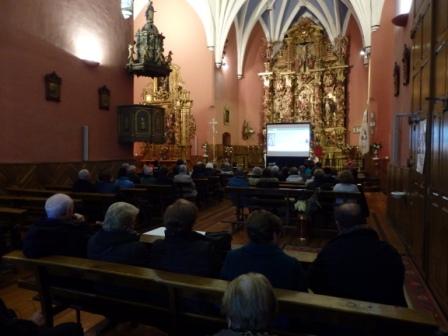21 November
Conferences
OUR HERITAGE, OUR bequestTESTIMONY OF TRADITIONS AND BELIEFS
Beyond the stones
Ms. Sagrario Anaut Bravo
Public University of Navarra
Within the historical-artistic cycle of Pitillas: Our heritage, our bequest, is framed the Cultural workshop , Testimony of beliefs and traditions, on November 21, 2015. The event is held in the parish of San Pedro de Pitillas, where the temporary exhibition : Embroidery and ceremonial rites has also been installed.
The workshop is the closing of the project partially funded by the Caja Navarra Foundation in 2015: Restoration, Conservation and knowledge dissemination of the Religious Heritage of Pitillas: Ornaments and Clothing.
Its goal has been to disseminate a part of the historical and artistic heritage of the town. A heritage that speaks of a shared historical report through a religious experience and a spirituality, which have been manifested both in a specific Closed space (parish church) and in the public spaces of the town (streets and squares).
It is also intended to raise awareness of the importance of preserving a heritage that is very sensitive to deterioration or destruction, such as textiles, embroidery and small ornaments. The fact that it has reached the present day in good condition has had to do with the silent work of many women who embroidered, sewed, ironed, mended, etc., part of these ornaments and liturgical vestments. They did it, first as schoolgirls or nuns at St. Joseph's high school (Jesuitinas), then as workers in the local sewing workshop or as housewives. We must also recognize the generosity of priests of local descent who donated some of their personal liturgical objects. In summary, these ornaments and liturgical vestments speak of traditions and beliefs rooted in the identity of the town, in this case, Pitillas.
In this line will be the speech of the first lecture: Beyond the stones. A shared culture, which was position by Dr. Sagrario Anaut Bravo (Public University of Navarra). That is, it will focus on the importance of maintaining and preserving a culture that is necessarily shared because it is based on an identity that is built and supported by its history. A history that is not always in the books, in the archives, but is everything that has shaped a sense of belonging with other people who feel and experience that same feeling. From there, links have been forged that shape a shared culture.
To strengthen these ties, it is essential to know the past and to trace the traces it has left behind. Traces that have not always been preserved. Some have been partially or totally erased. Others have been fully preserved or are more visible. It is when we combine and relate these clear traces with those weak ones that we are able to understand our history and, with it, our cultural identity. Given this circumstance, it is worth asking ourselves: how can we detect those traces, traces, that give identity as a people (even if we were not born there) and what are those traces?
The focus will not be on the most visible architectural and urban heritage, of which there are numerous examples in the town. The focus will be on other historical sources that shape the set of symbolic elements that link the past with the present and help build the future, both near and distant. In this sense, a journey through songs, biographical accounts, photographs, letters, family and business documents, glass, brass and tin objects, clothes, farming tools, etc. will be made. Therefore, the aim is to revalue a heritage that is little known and, therefore, little appreciated.
The dissertation concludes with a question that is left for the audience's reflection: what is the role of each person in this double task of maintaining a heritage that gives identity as a community and of leaving a bequest to the younger ones?

The conferences took place in the parish church of San Pedro de Pitillas.
The second lecture, Our Patrimonial Wealth: Liturgical Ornaments, at positionby Dr. Alicia Andueza.
Finally, the inauguration of the exhibitionBordados took place. Ms. Covadonga Anaut Bravo explained, before going on to see it, that many liturgical vestments and ornaments have not reached the present day due to the successive wars, especially in the 19th century, and the fragility of the Materials (fabrics and metal objects). From indirect and oral information, two hypotheses are put forward to explain this generalised reality in many parishes where emigration significantly reduced the number of parishioners: the carrying out of major works that had to be paid for to avoid collapse (1906-08 and 1859-62) and the distribution to other parishes that opened in urban areas, coinciding with the changes in liturgical rites introduced by the Second Vatican Council.
Bearing this context in mind, the exhibitionincludes the donation made by the bishop Don. José Cadena y Eleta, a native of Pitillas: evangelical vestment, pallium, monstrance and altar set. In addition, the embroidery on liturgical cloths and tablecloths. All this is illustrated in a photographic exhibitionshowing all the objects on display, which were used in the chant masses celebrated in the town prior to the Second Vatican Council.
